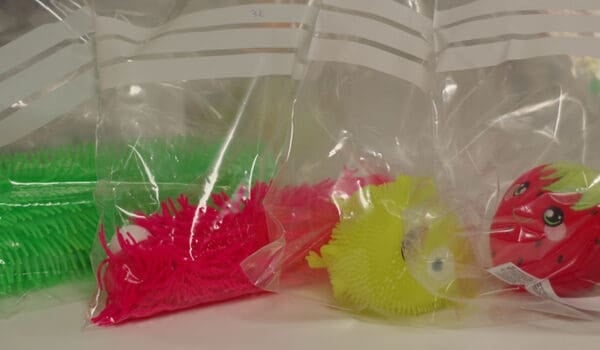From NILU’s Annual Report 2020: Have you heard of “squishies”? They’re those soft, brightly coloured foam toys that have taken over Norwegian toy stores and children’s rooms in recent years. Children play with them, collect them, and cuddle with them. But is that safe?
“Not necessarily,” says Pernilla Bohlin-Nizzetto, senior scientist at NILUs Environmental Chemistry Department.
Soft, perfumed toys
On behalf of the Norwegian Environment Agency, Bohlin-Nizetto and senior scientist Norbert Schmidbauer at NILU’s Department of Monitoring and Instrumentation Technology have studied a selection of toys for children under three, including “squishies”.
The objective was to find out whether the toys contain and release volatile organic compounds (VOCs) to indoor air in amounts that might be harmful.
Some VOCs can irritate eyes and airways, among their other effects. Prolonged exposure can damage the liver, the kidneys and the nervous system, and increase the risk of cancer. VOCs have also been linked to asthma, or exacerbation of asthma.
“Squishies” are toys made of soft, colourful polyurethane foam and are often perfumed. The foam the toys are made of contains VOCs, among other substances. The purpose of this study was to determine which VOCs are released, and in what amounts. At the same time, the researchers from NILU wanted to find out if other toys made of plastic or rubber contain and release VOCs.
Toys in the laboratory
Bohlin-Nizzeto and Schmidbauer examined the toys in two stages. First, all the toys the Environment Agency had purchased at various brick-and-mortar and online toy stores in Norway were collected in the laboratory at NILU. Each toy was unpacked from its wrapping and placed individually in an air-tight ziplock bag along with a Tenax TA passive air sampler. The bag was filled with pure, VOC-free air and sealed.

“We left the bags at room temperature for 24 hours before taking out and analysing the air samplers,” says Bohlin-Nizzetto.
What they found was not encouraging.
“We found between 12 and 30 different VOCs per toy, at concentrations well above the detection limit, and the chemicals were clearly identifiable,” says Bohlin-Nizetto. “Taking all the toys together, we found nearly 150 different VOCs.”
She goes on to explain that the levels of all the VOCs emitted by some toys were extremely high. If the toy that emitted most had been placed in a child’s room, it would have been a greater source of VOCs than walls, flooring, or furniture.
How is indoor air affected?
After these initial analyses, and in cooperation with the Environmental Agency, the researchers selected the twelve toys with the highest VOC emissions and subdivided them according to the type of compound released.
Bohlin-Nizetto and Schmiedbauer wanted to find out how the chemicals emitted from the toys affect the air inside a home. To simulate that environment as realistically as possible, they borrowed an unoccupied 40-square-metre apartment containing a child’s room of about 6 square metres.
“Since nobody lived there, the apartment was free of skin care and cleaning products, and also lacked clothing that could influence our measurements,” says Norbert Schmidbauer. “That meant we could be fairly certain that our samplers would capture whatever came from the toys.”

They put the first group of toys in the apartment, placing them at the head of the bed in the child’s room. Then they put Tenax TA samplers in three different locations within the apartment: one was placed in the bed, alongside the toys, to measure emissions in the immediate vicinity of where the child’s head would be. The second sampler was positioned at the opposite end of the same room, and the third sampler was placed in the living room.
“We left the first group of toys in the bed for ten hours,” says Schmidbauer. “Then we removed both the toys and the samplers, aired the room out for 24 hours, and set out the second group of toys and samplers. We repeated this until we had measured emissions from all four groups of toys. The results from this second stage of the experiment showed that the toys with high levels of cyclohexanones and cyclic siloxanes also affected the indoor air. When these toys were placed in the child’s room, the levels of VOCs in the indoor air increased so much that further examination of potential health risks is warranted.”
Conversely, the toys with high levels of aromatic VOCs and the plasticiser TXIB (a potential irritant) did not affect the VOC levels in the apartment’s indoor air.
“One explanation might be that the aromatic VOCs had already evaporated during the time that passed between stage 1 in November and stage 2 in February,” says Bohlin-Nizzetto. “We noticed that the toys smelled less when we unpacked them in the apartment than they had when they were new.”
Air those toys!
This single study in isolation does not allow the researchers from NILU to conclude that “squishies” are harmful to the health of children who play with them or sleep alongside them. But they are concerned by their results, and want additional research on this topic.
Meanwhile, they advise against unpacking new, strongly scented toys and placing them directly into a child’s bed or room. Since the VOC emissions appear to decline over time, they recommend putting new toys in a well-ventilated place to “air out” first.
The Norwegian Environment Agency will continue examining whether the VOCs the toys emit could pose a risk to children’s health. The Agency will also assess the need for additional follow-up within the EU.




